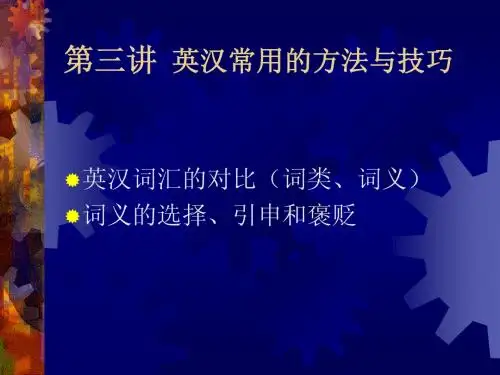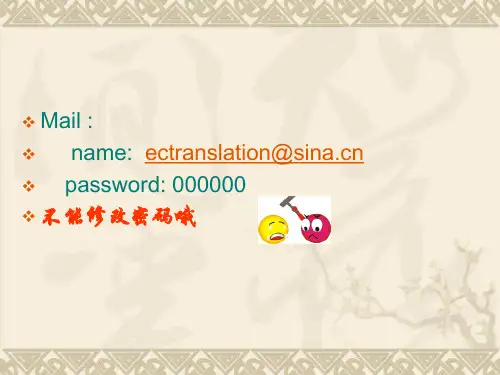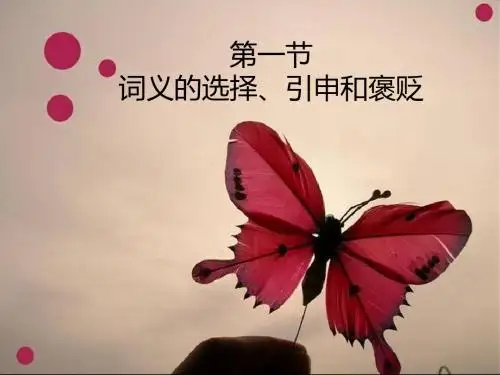第一讲词义选择引申褒贬解析
- 格式:ppt
- 大小:1.70 MB
- 文档页数:37
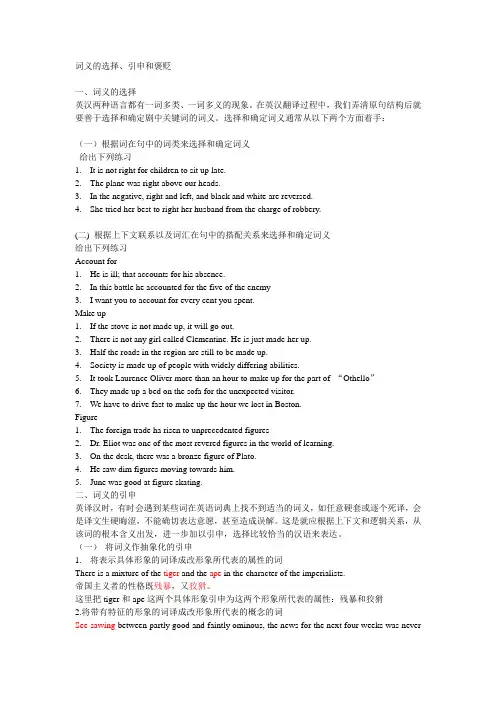
词义的选择、引申和褒贬一、词义的选择英汉两种语言都有一词多类、一词多义的现象。
在英汉翻译过程中,我们弄清原句结构后就要善于选择和确定剧中关键词的词义。
选择和确定词义通常从以下两个方面着手:(一)根据词在句中的词类来选择和确定词义给出下列练习1.It is not right for children to sit up late.2.The plane was right above our heads.3.In the negative, right and left, and black and white are reversed.4.She tried her best to right her husband from the charge of robbery.(二) 根据上下文联系以及词汇在句中的搭配关系来选择和确定词义给出下列练习Account for1.He is ill; that accounts for his absence.2.In this battle he accounted for the five of the enemy3.I want you to account for every cent you spent.Make up1.If the stove is not made up, it will go out.2.There is not any girl called Clementine. He is just made her up.3.Half the roads in the region are still to be made up.4.Society is made up of people with widely differing abilities.5.It took Laurence Oliver more than an hour to make up for the part of “Othello”6.They made up a bed on the sofa for the unexpected visitor.7.We have to drive fast to make up the hour we lost in Boston.Figure1.The foreign trade ha risen to unprecedented figures2.Dr. Eliot was one of the most revered figures in the world of learning.3.On the desk, there was a bronze figure of Plato.4.He saw dim figures moving towards him.5.June was good at figure skating.二、词义的引申英译汉时,有时会遇到某些词在英语词典上找不到适当的词义,如任意硬套或逐个死译,会是译文生硬晦涩,不能确切表达意愿,甚至造成误解。


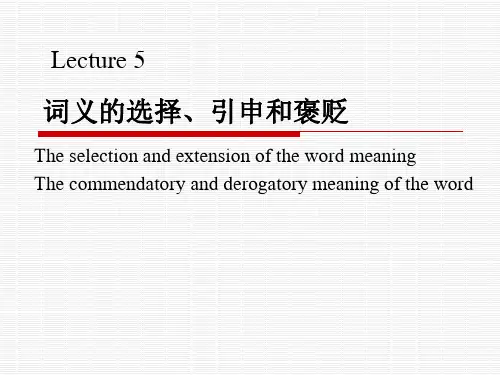
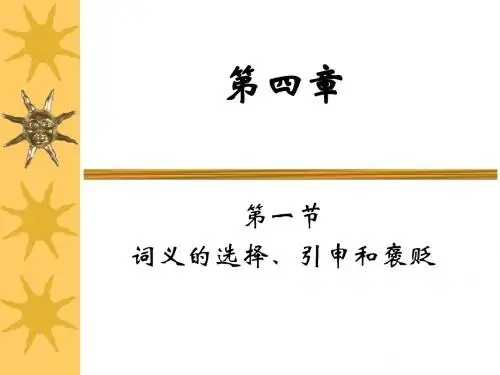
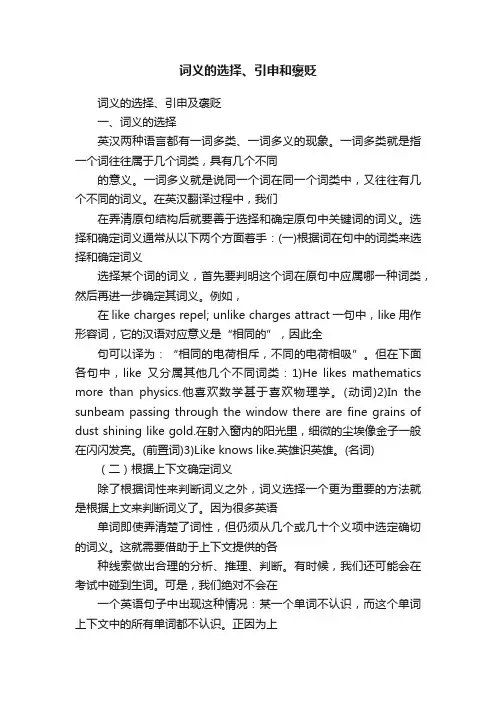
词义的选择、引申和褒贬词义的选择、引申及褒贬一、词义的选择英汉两种语言都有一词多类、一词多义的现象。
一词多类就是指一个词往往属于几个词类,具有几个不同的意义。
一词多义就是说同一个词在同一个词类中,又往往有几个不同的词义。
在英汉翻译过程中,我们在弄清原句结构后就要善于选择和确定原句中关键词的词义。
选择和确定词义通常从以下两个方面着手:(一)根据词在句中的词类来选择和确定词义选择某个词的词义,首先要判明这个词在原句中应属哪一种词类,然后再进一步确定其词义。
例如,在like charges repel; unlike charges attract一句中,like用作形容词,它的汉语对应意义是“相同的”,因此全句可以译为:“相同的电荷相斥,不同的电荷相吸”。
但在下面各句中,like又分属其他几个不同词类:1)He likes mathematics more than physics.他喜欢数学甚于喜欢物理学。
(动词)2)In the sunbeam passing through the window there are fine grains of dust shining like gold.在射入窗内的阳光里,细微的尘埃像金子一般在闪闪发亮。
(前置词)3)Like knows like.英雄识英雄。
(名词) (二)根据上下文确定词义除了根据词性来判断词义之外,词义选择一个更为重要的方法就是根据上文来判断词义了。
因为很多英语单词即使弄清楚了词性,但仍须从几个或几十个义项中选定确切的词义。
这就需要借助于上下文提供的各种线索做出合理的分析、推理、判断。
有时候,我们还可能会在考试中碰到生词。
可是,我们绝对不会在一个英语句子中出现这种情况:某一个单词不认识,而这个单词上下文中的所有单词都不认识。
正因为上下文的存在,这也给我们翻译中解决生词提供了突破口。
因此,在翻译中,我们一定要随时注意上下文,上下文的不同在很大程度上决定了单词意义的不同,也在很大程度上决定了翻译中理解和表达的正确性、准确性和译文是否通顺。
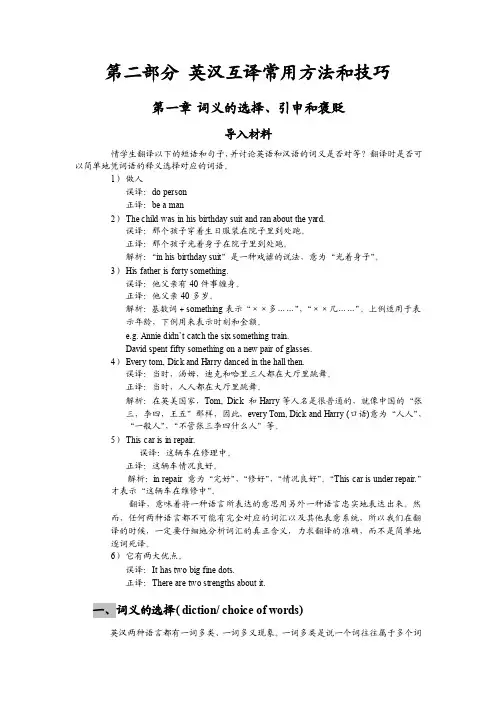
第二部分英汉互译常用方法和技巧第一章词义的选择、引申和褒贬导入材料情学生翻译以下的短语和句子,并讨论英语和汉语的词义是否对等?翻译时是否可以简单地凭词语的释义选择对应的词语。
1)做人误译:do person正译:be a man2)The child was in his birthday suit and ran about the yard.误译:那个孩子穿着生日服装在院子里到处跑。
正译:那个孩子光着身子在院子里到处跑。
解析:‚in his birthday suit‛是一种戏谑的说法,意为‚光着身子‛。
3)His father is forty something.误译:他父亲有40件事缠身。
正译:他父亲40多岁。
解析:基数词+something表示‚××多……‛,‚××几……‛。
上例适用于表示年龄,下例用来表示时刻和金额。
e.g. Annie didn‟t catch the six something train.David spent fifty something on a new pair of glasses.4)Every tom, Dick and Harry danced in the hall then.误译:当时,汤姆,迪克和哈里三人都在大厅里跳舞。
正译:当时,人人都在大厅里跳舞。
解析:在英美国家,Tom, Dick 和Harry等人名是很普通的,就像中国的‚张三,李四,王五‛那样,因此,every Tom, Dick and Harry (口语)意为‚人人‛,‚一般人‛,‚不管张三李四什么人‛等。
5)This car is in repair.误译:这辆车在修理中。
正译:这辆车情况良好。
解析:in repair 意为‚完好‛,‚修好‛,‚情况良好‛。
‚This car is under repair.‛才表示‚这辆车在维修中‛。

